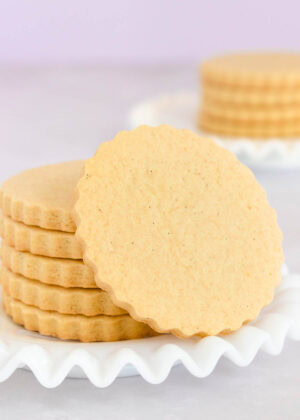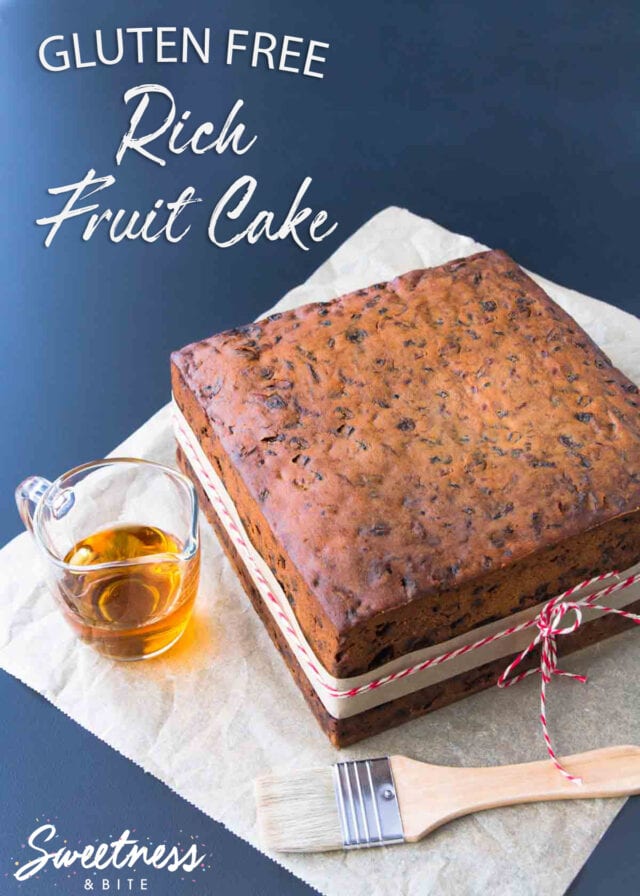Gluten Free Fruit Cake (Christmas Cake)
This post may contain affiliate links to products I recommend. I receive a small commission at no cost to you if you make a purchase using my link.
A rich, moist gluten-free fruit cake, laced with brandy ~ this is the perfect gluten free Christmas cake or traditional wedding cake.
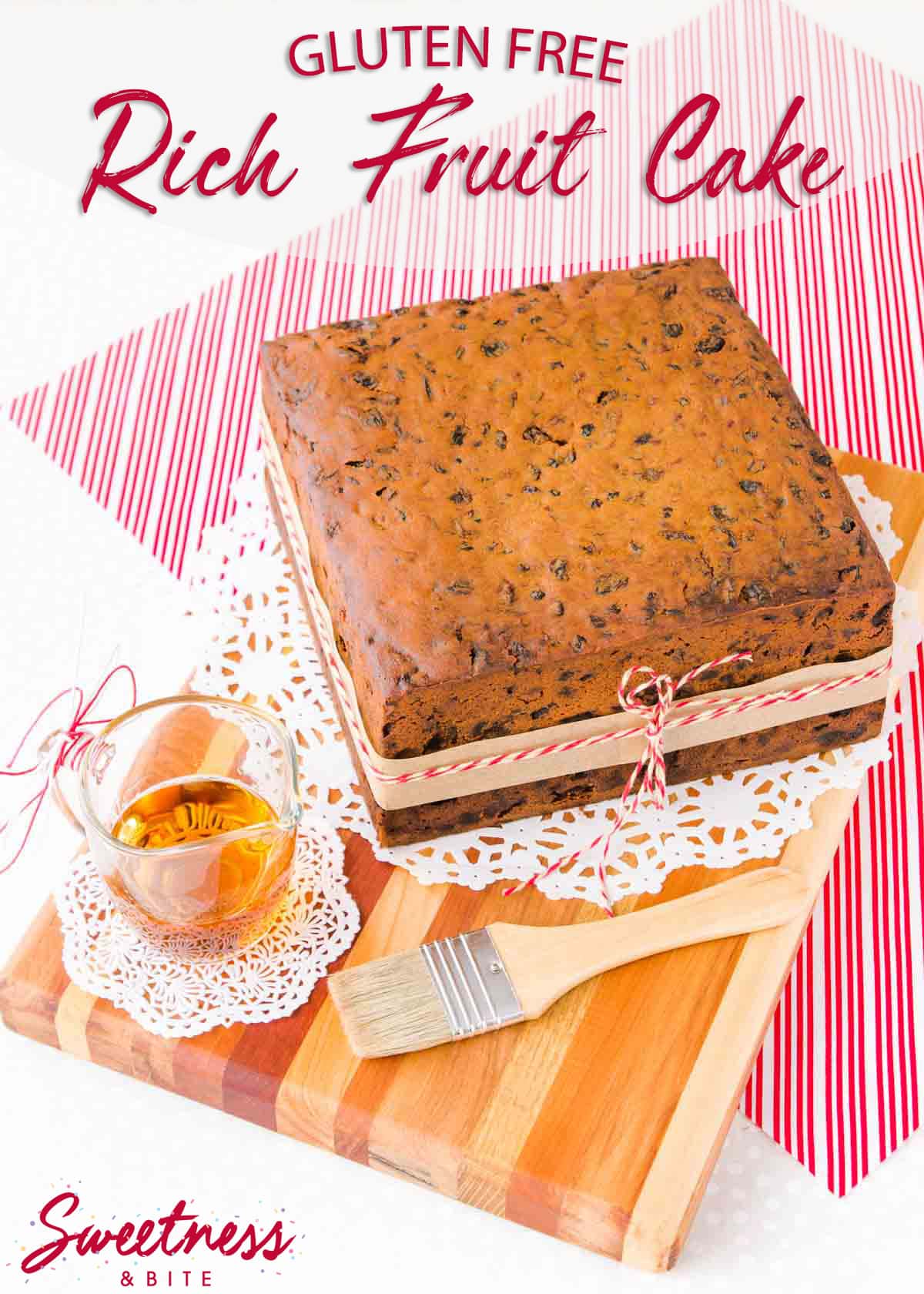
The way I see it, there are two kinds of people who have read the heading of this post. The ones who like fruit cake, and the ones who are about to stop reading now, because they hate fruit cake with the burning fire of a thousand angry suns.
If you do happen to be of the second sort, hear me out. I used to hate fruit cake, but when my Dad was diagnosed with Coeliac disease and I had to start making a gluten free Christmas cake for our family, I realised what actually goes into a fruit cake, and which parts I didn’t like. And so I fixed them – making, what is, in my not-so-humble opinion, The Best Gluten Free Fruit Cake recipe, and The Best Gluten Free Christmas Cake recipe, too!
One of those things I didn’t like was mixed peel. I am not a fan of mixed peel. That’s an easy fix, I know I don’t like it so I don’t put it in.
This one here is the big one: I cannot stand the taste of burnt fruit.
But don’t worry, I have two easy fixes for that, too. So let’s get into it!
Ingredients
Mixed Dried Fruit – I have some notes below on choosing the fruit for your fruit cake. Big tip – buy fruit that already looks nice and plump, and you’ll have a head-start on a super moist cake.
Glacé Cherries (optional) – If you don’t like these, you can replace them with an equal amount of any other dried fruit.
Glacé Ginger (optional) – Leave it out if you’re not a fan.
Citrus zest – Lemon zest and orange zest are both great in this, use whichever you have on hand.
Gluten Free Plain Flour – I like to use my homemade gluten free baking flour blend, but this cake works great with commercial gluten free plain or all-purpose flour blends as well. If you’ve stumbled across this recipe and don’t need the cake to be gluten free, you can swap the gluten-free flour for all-purpose wheat flour instead.
Xanthan Gum – This helps to bind the cake together and stop it from crumbling. If using a commercial flour blend that contains a gum ingredient, you can leave out the xanthan gum.
Ground Spices – Cinnamon, Mixed Spice, Ginger, Cardamom and Nutmeg I like lots of spices in my fruit cakes, but you can adjust these to suit your own taste.
Butter – I use salted butter in this recipe, but if unsalted butter is all you have you can use that and add a pinch of salt to the batter. For a dairy free fruit cake, you should be able to use any dairy-free butter alternative that is suitable for baking.
Brown Sugar – Dark or light brown sugar will work in this recipe, and it’s also great with muscovado sugar.
Golden Syrup – For a darker, richer cake you can use molasses instead.
Vanilla Extract – Y’all know I love vanilla in everything.
Large Eggs – That’s all. Just large eggs.
Brandy – Brandy is the traditional choice for fruit cakes, but you can use any alcohol that you like – rum, whiskey, bourbon, orange liqueur, cherry brandy and amaretto would all work.
Alcohol free fruit cake: If you can’t or don’t want to use alcohol, then you can use fruit juice (orange juice or apple juice are good options) to soak the fruit instead. Just be aware that if you don’t use any alcohol in your cake and if you don’t brush it with alcohol once it’s baked, it won’t have quite the same keeping qualities as a boozy one.
Note: It is correct that there is no baking powder or baking soda in this recipe – we don’t need the cake to be light and fluffy, and it will keep a tighter crumb and be much less likely to crumble without any raising agent.
Choosing Dried Fruits for Your Cake
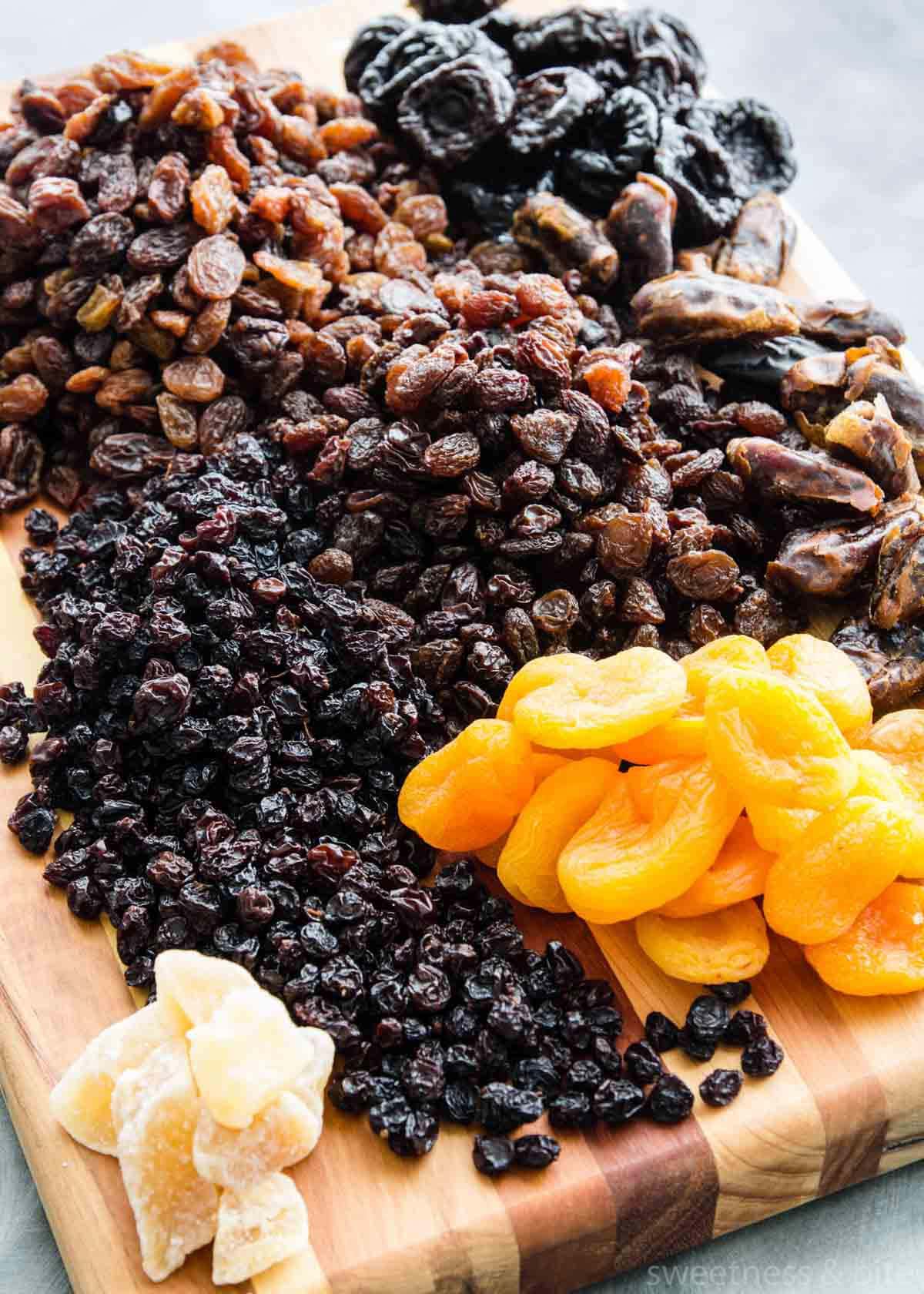
You can simply buy a dried fruit mix from the supermarket, but since a lot of them contain mixed peel, I obviously avoid them. But if you find a mix you like, then buy it! It’ll save you a bit of time.
For our cakes, I prefer to buy the fruits individually and use them to make up the total fruit weight. You can pretty much use any dried or candied fruits that you like.
I happen to really like sultanas (golden raisins) so I use a bit more of them than the other fruits. As well as the sultanas, I like to use raisins, currants, dates, prunes, dried apricots and glacé ginger. Oh, and these polarising bad boys…
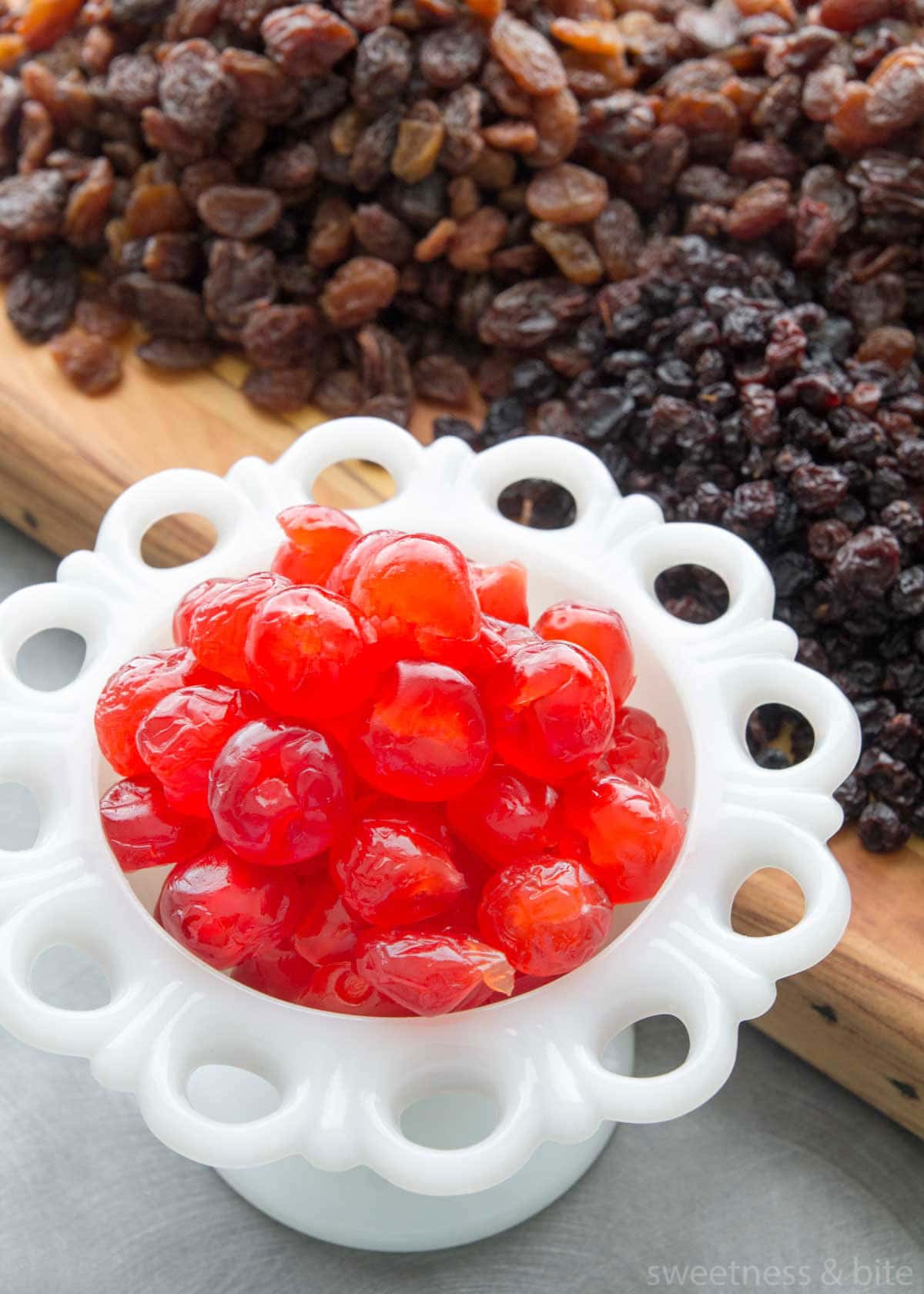
Glacé cherries.
I love these. For me, half the enjoyment of making fruit cake is eating these while making it. In fact, I often add extra just because I know that every time I stir the fruit mix, I’m going to pick out and eat a few more cherries. It’s a thing, for me. A Christmas thing. It makes me happy.
But I know a lot of people don’t like ‘em, so if that’s you, by all means, leave them out. Remember, we’re only using the fruits we like. It’s a fruit cake revolution, people!
How to Prepare a Cake Tin for Fruit Cakes
This is the best way to prevent burnt fruit on the edges of your fruit cake.
Fruit cakes take a long time to bake. That’s why since the beginning of time (or whenever they started making fruit cakes) people have wrapped their fruit cake tins in layers of brown paper and/or newspaper to protect the cake from the heat of the oven, and stop the outside of the cake from burning before the inside is cooked.
I don’t know what the people whose fruit cakes I had tasted were doing, but whatever they were doing was not stopping the fruit from burning on the outside.
Then I started making foil-and-paper-towel baking strips for my mud cakes, and realised I could use them for fruit cakes too.
Baking strips work so much better for insulating the cake than the newspaper ever could, and better yet your house will smell only of delicious fruit cake, and not of burning paper. Or burning fruit!
Check out the video below to see how I prepare the cake tin, or scroll down for photos showing the process.
How To Make A Gluten Free Fruit Cake
Making a fruit cake is a bit of a process and this gluten-free fruit cake is no different in that regard, but the steps themselves are all pretty easy.
Start by chopping any larger fruits like apricots and dates into smaller pieces, about the same size as a raisin.
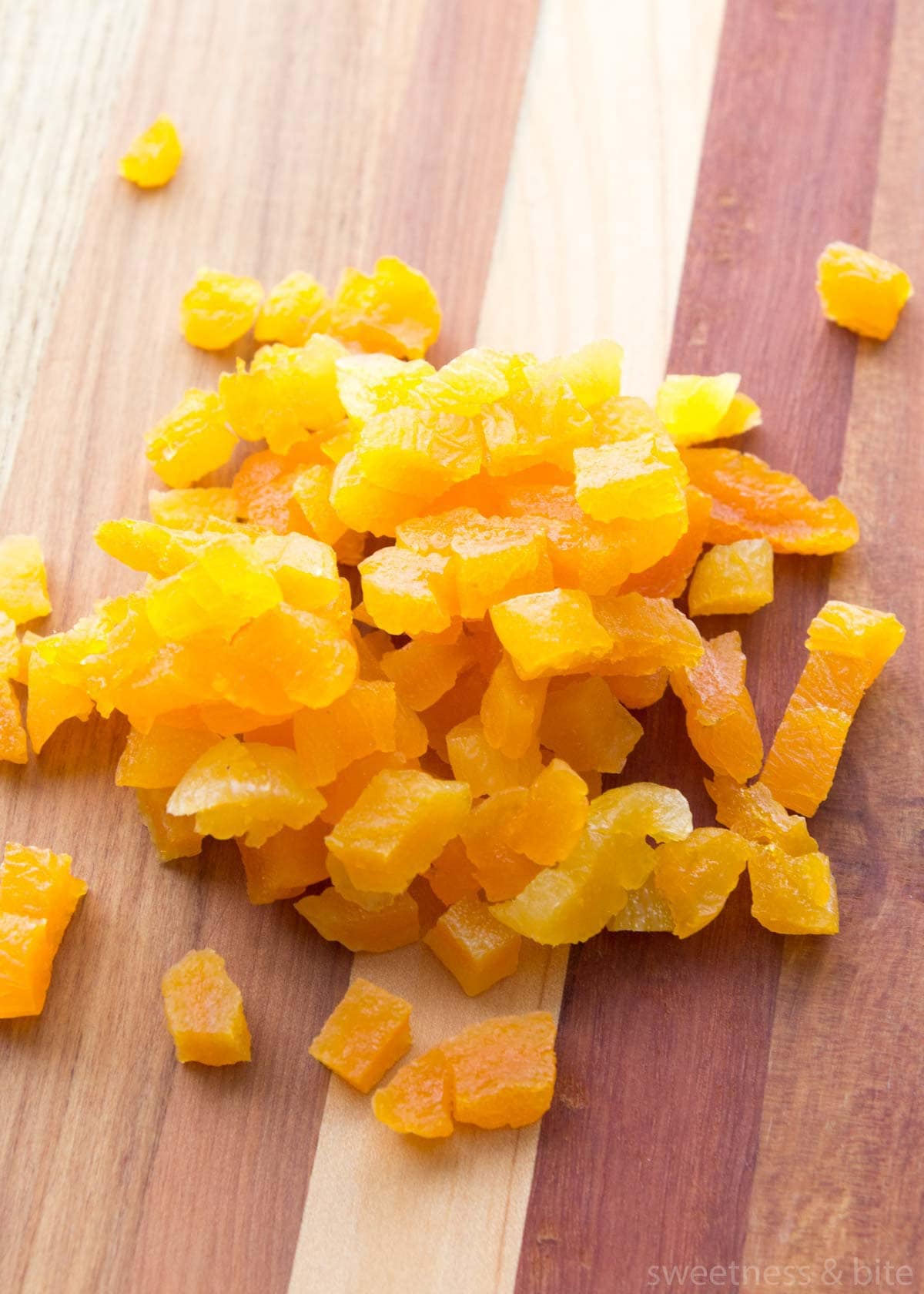
Then rinse the fruit under warm running water. I usually rinse each of the fruits as I measure them, and as I chop each of the larger fruits. If you’re using a pre-mix of dried fruits, just rinse it in batches, as much as will fit in your colander or sieve at a time.
Rinsing the fruit gets any of that sugary, dusty, cloudy stuff off them and also starts moistening and plumping the fruit up.
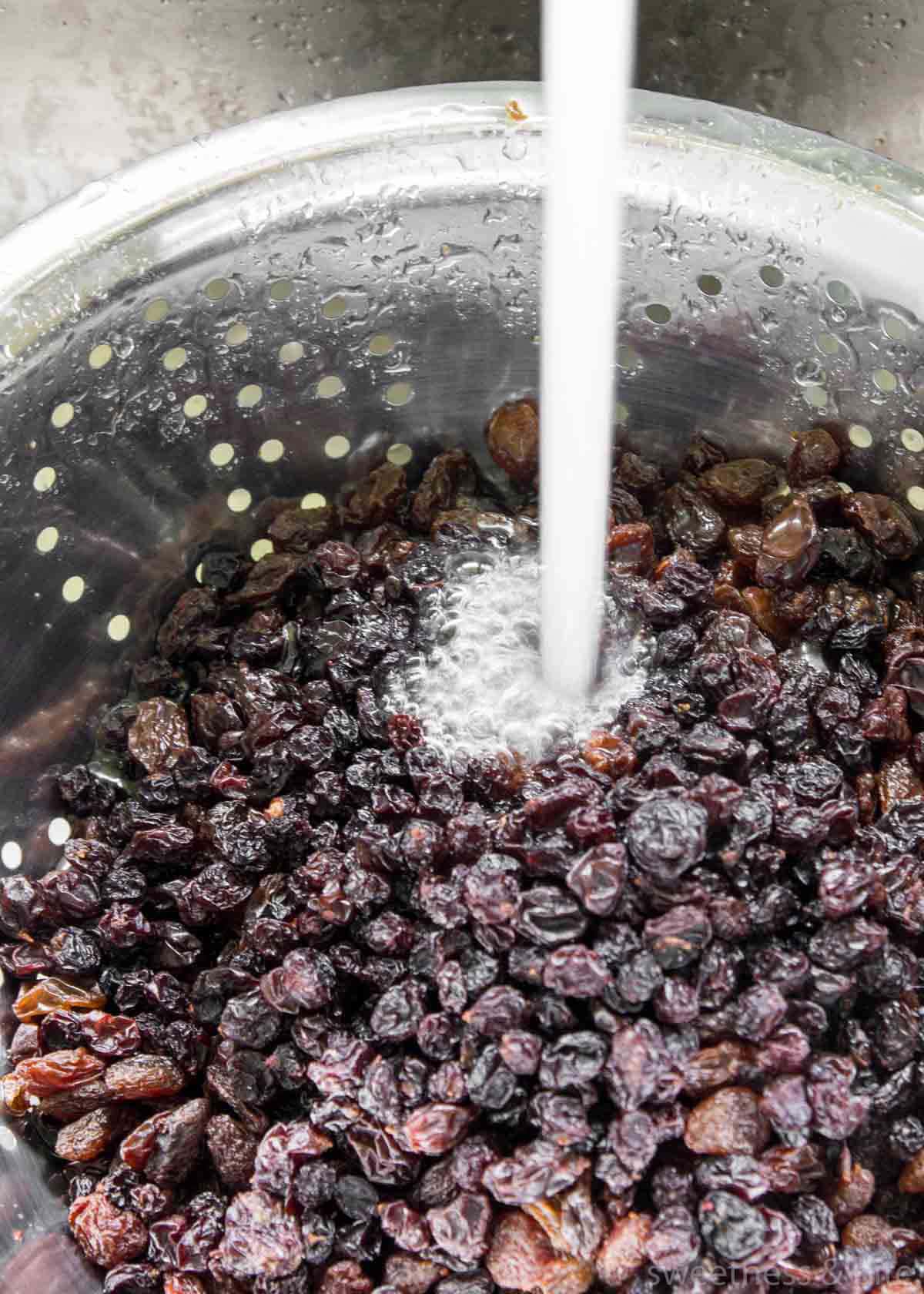
Your fruit needs to be plump. Just sayin’.
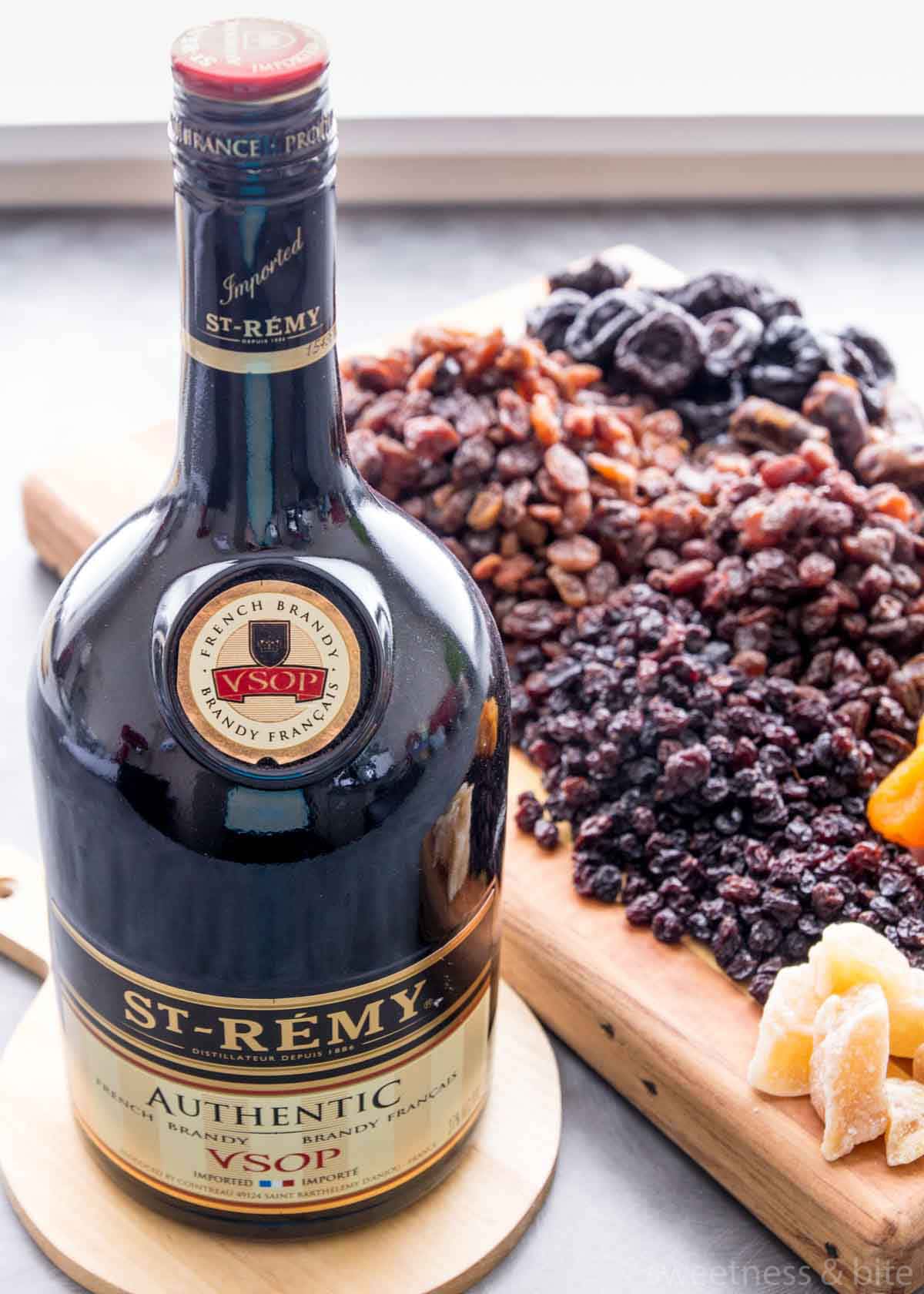
Then you can add the glace ginger (if using) and the citrus zest, then slosh over your alcohol of choice.
I like to mix the fruit and alcohol in a large airtight container. Once you close the lid the liquid can’t evaporate – it has no choice but to be absorbed by the fruit. Plus it means that in between stirs, I can just shake the container to mix it all up. (This also saves a few cherries from being eaten, just quietly.)
It needs to be left at least overnight, (a few days is even better) for the fruit to soak up all of the alcohol.
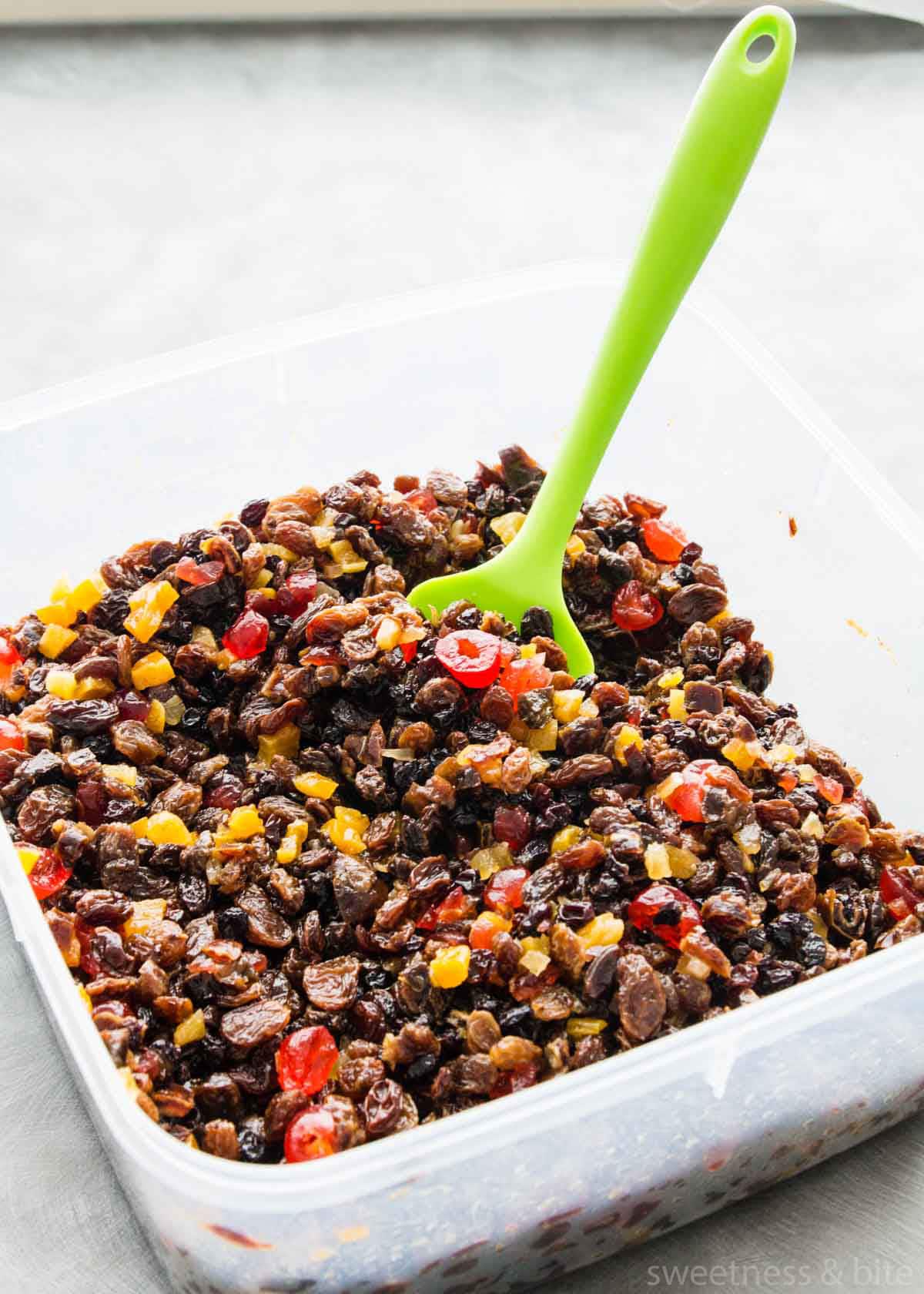
Once your fruit has sat and done its thing, you can mix up the batter. If the creamed butter-sugar mixture curdles after adding the eggs, don’t panic, it will come back together once the flour is added. You can beat it plenty, anyway – we don’t have to worry about overworking the gluten! Gluten free baking has its advantages.
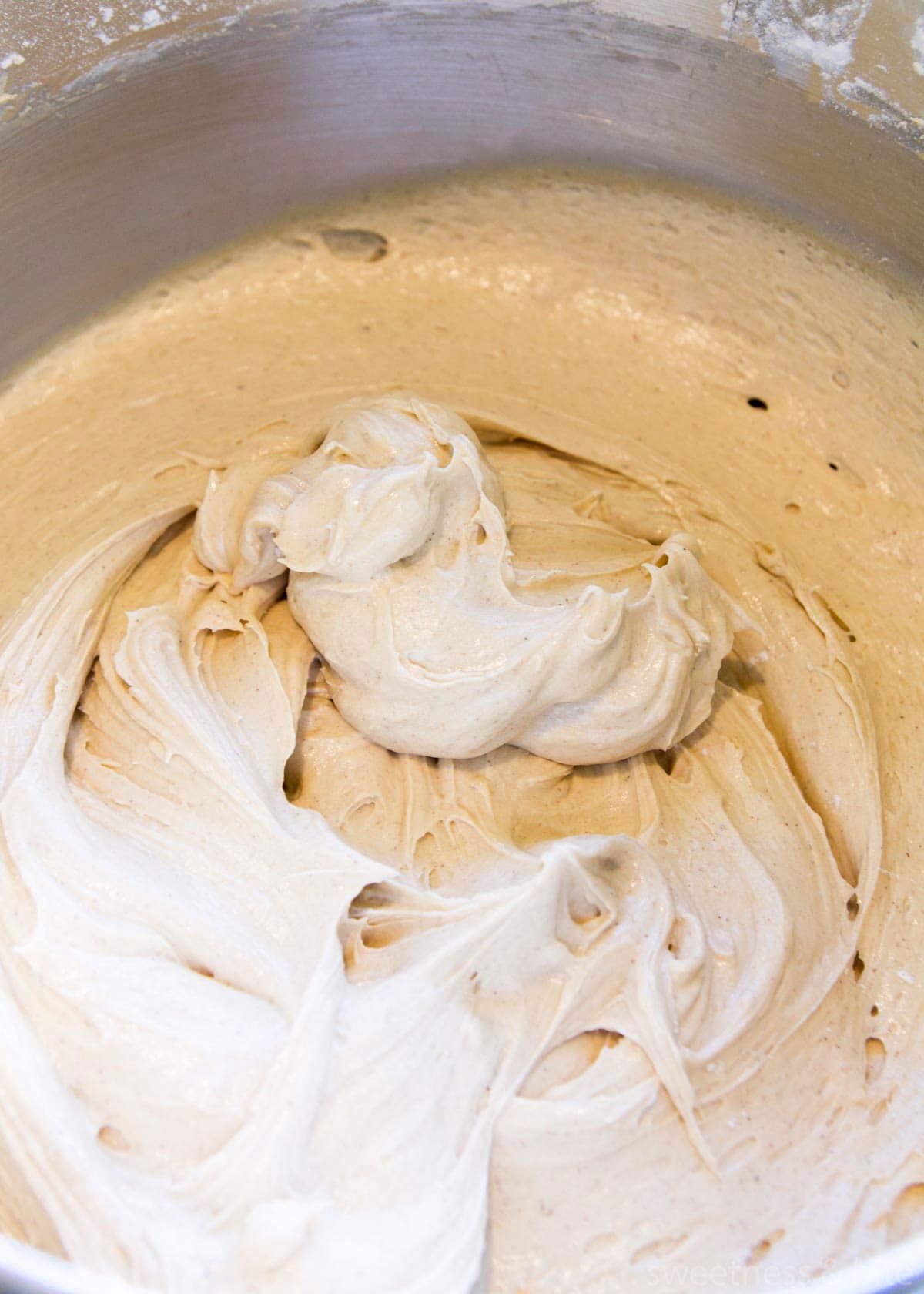
How to Prevent Fruit Holes in Fruit Cakes
This next step is my favourite trick for preventing “fruit holes” in your cake. If you’ve ever covered a fruit cake in marzipan and/or fondant or royal icing before, you’ll know that to get a smooth surface, you need to fill the little indents that the fruit causes on the sides of the cake.
Using this little trick will prevent most of those holes from occurring in the first place, and save you a ton of time!
After mixing up the batter and before adding the fruit, take a couple of spoonfuls of the batter and spread it gently into the bottom of the tin. You can do the sides too, if you like. Just make sure you’re careful not to scrunch the baking paper with the spatula.
Then pop the tin into the fridge while you’re adding the fruit to the remaining batter. Some of the fruit may sink down through the batter, but generally, you will get far fewer holes caused by the fruit that will need to be filled (with marzipan or almond icing, or fondant) before covering in fondant.
In the pictures I took for this post, I only did this trick on the bottom, but I usually do this on the sides as well now, which you’ll see if you watch the video at the top of this post.
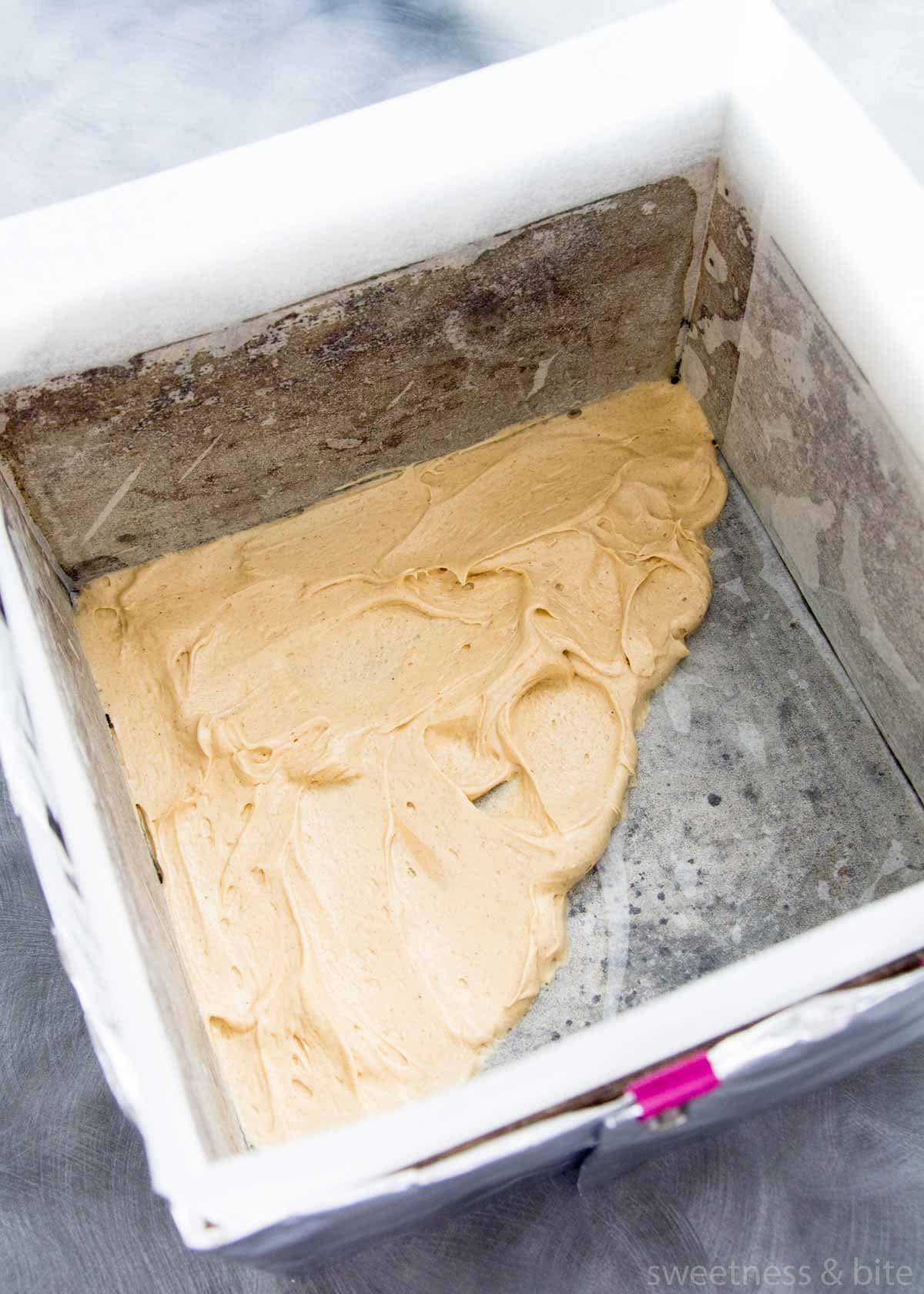
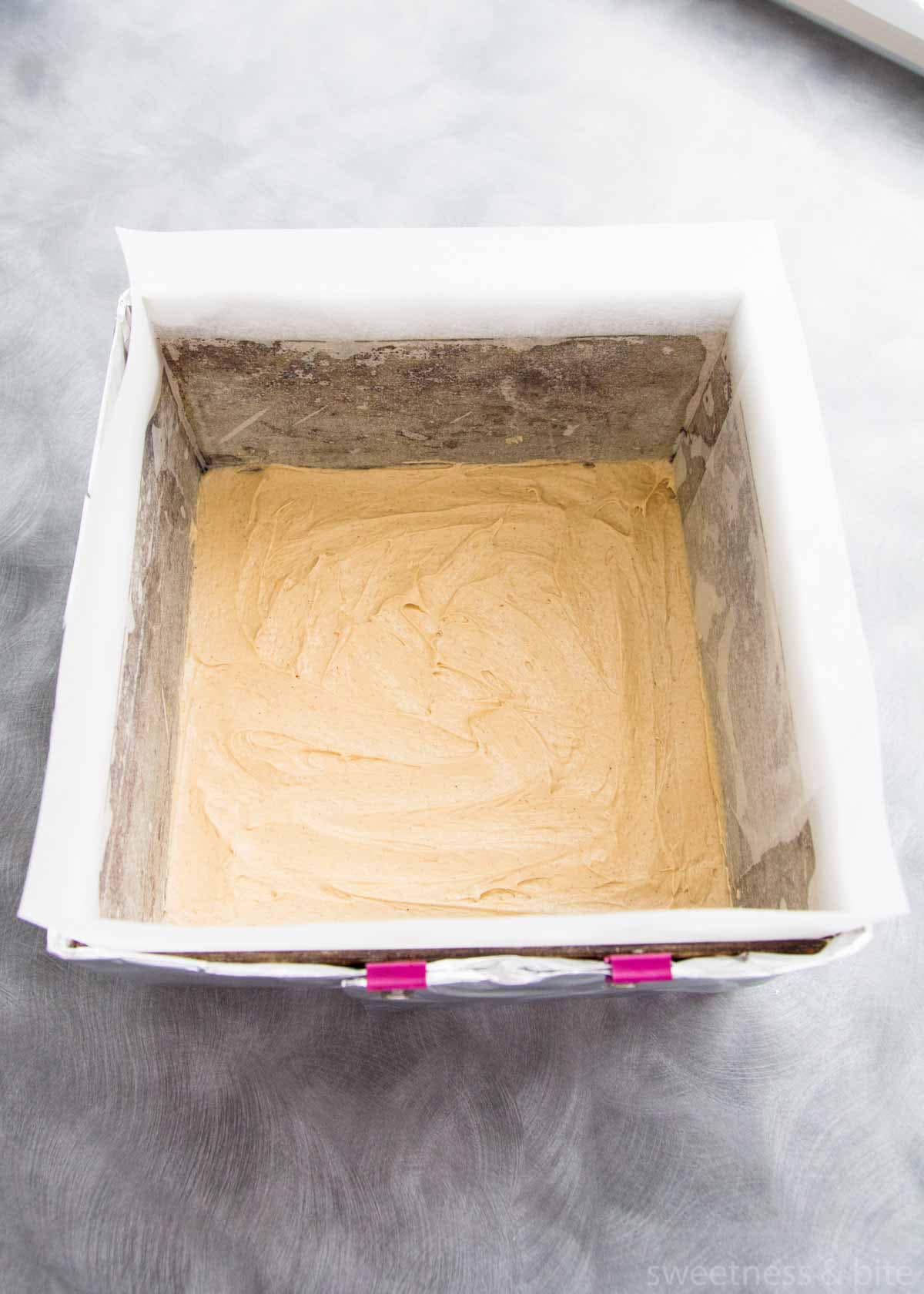
Then you can add your drunken fruit to the rest of the batter.
If your mixing bowl is too small, you can transfer the batter to a larger bowl or saucepan. I use our giant pasta pot. When doing an extra-large batch for multiple cakes, I’ve been known to use my Mum’s enormous preserving pan.
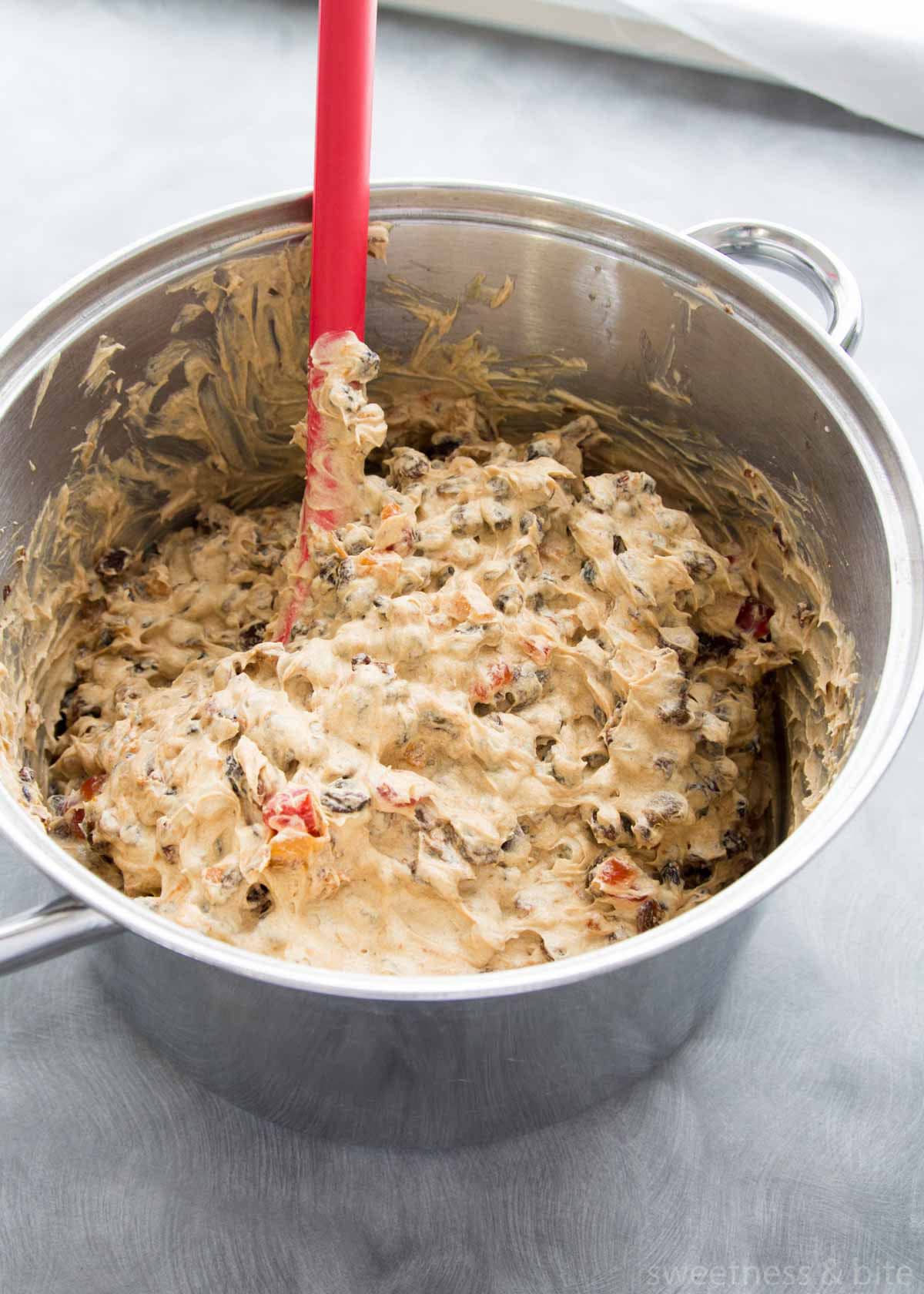
Now you can gently press it into your prepared cake pan. The batter lining should have firmed up in the fridge, and shouldn’t move too much as you add the rest of the batter. Add a few spoonfuls at a time and press it in with a spatula to make sure there aren’t any gaps. You can fill the tin up almost to the top, the cake has no raising agents, so it doesn’t rise much at all.
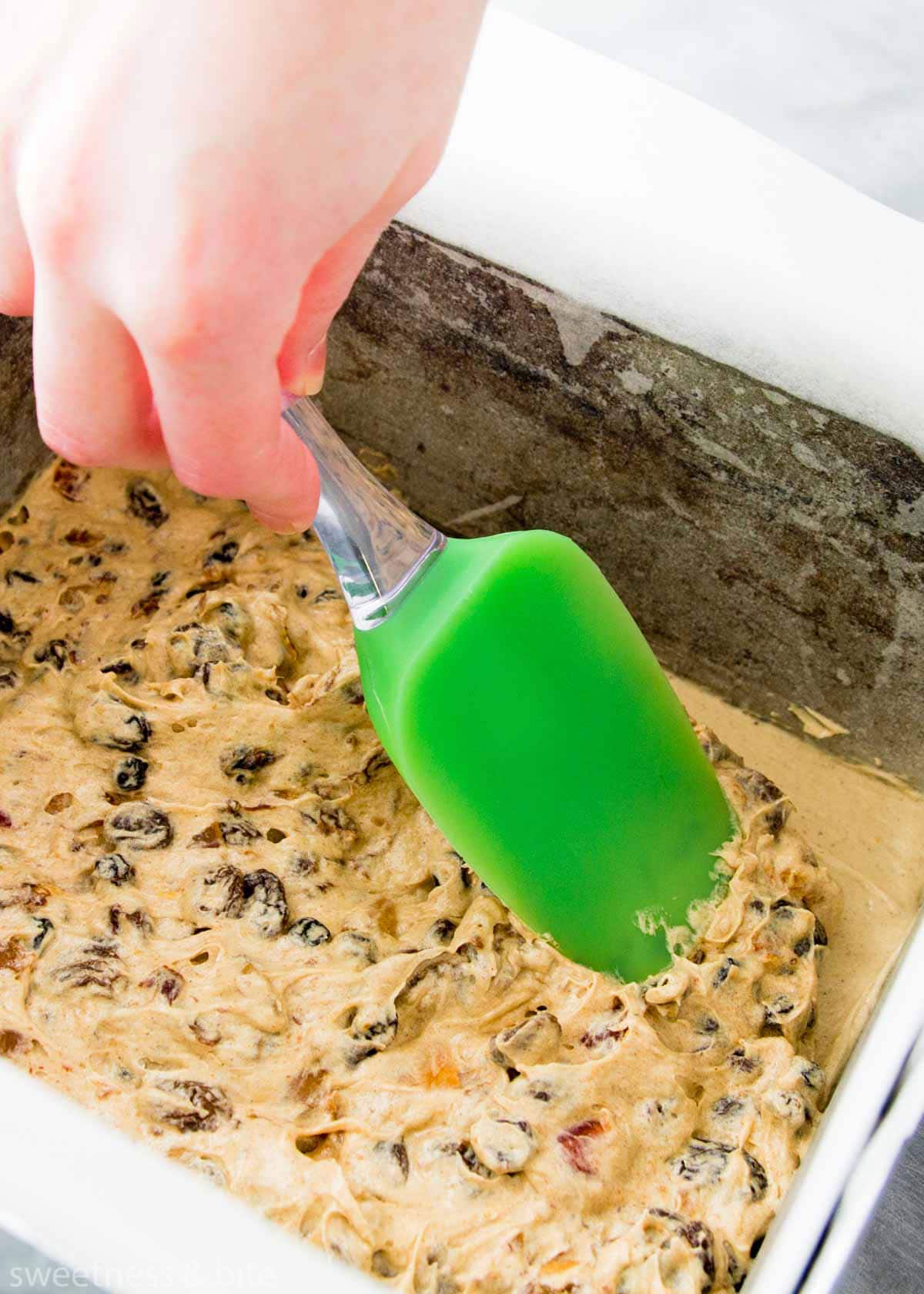
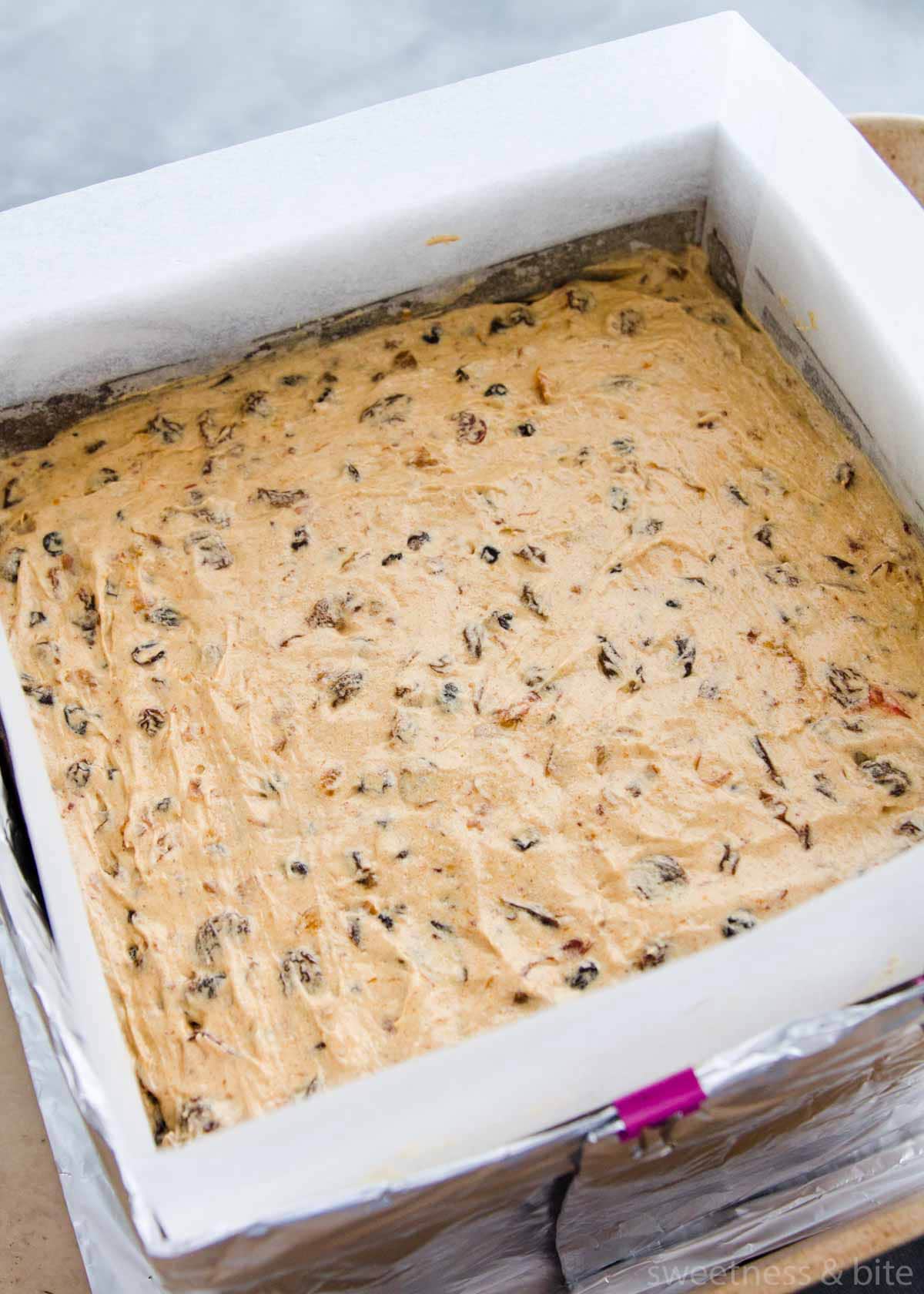
I’m not gonna lie to you, this cake takes some time to bake. Because it’s being baked at such a low temperature, it will take a good few hours to bake through. This low, slow baking will also help ensure the outside doesn’t burn before the centre is done.
Then, once it comes out of the oven you can brush the cake with more brandy.
This recipe is for an 8″ square fruitcake, but you could also bake this in two loaf tins if you want to make a gluten free fruit loaf instead.
Storage
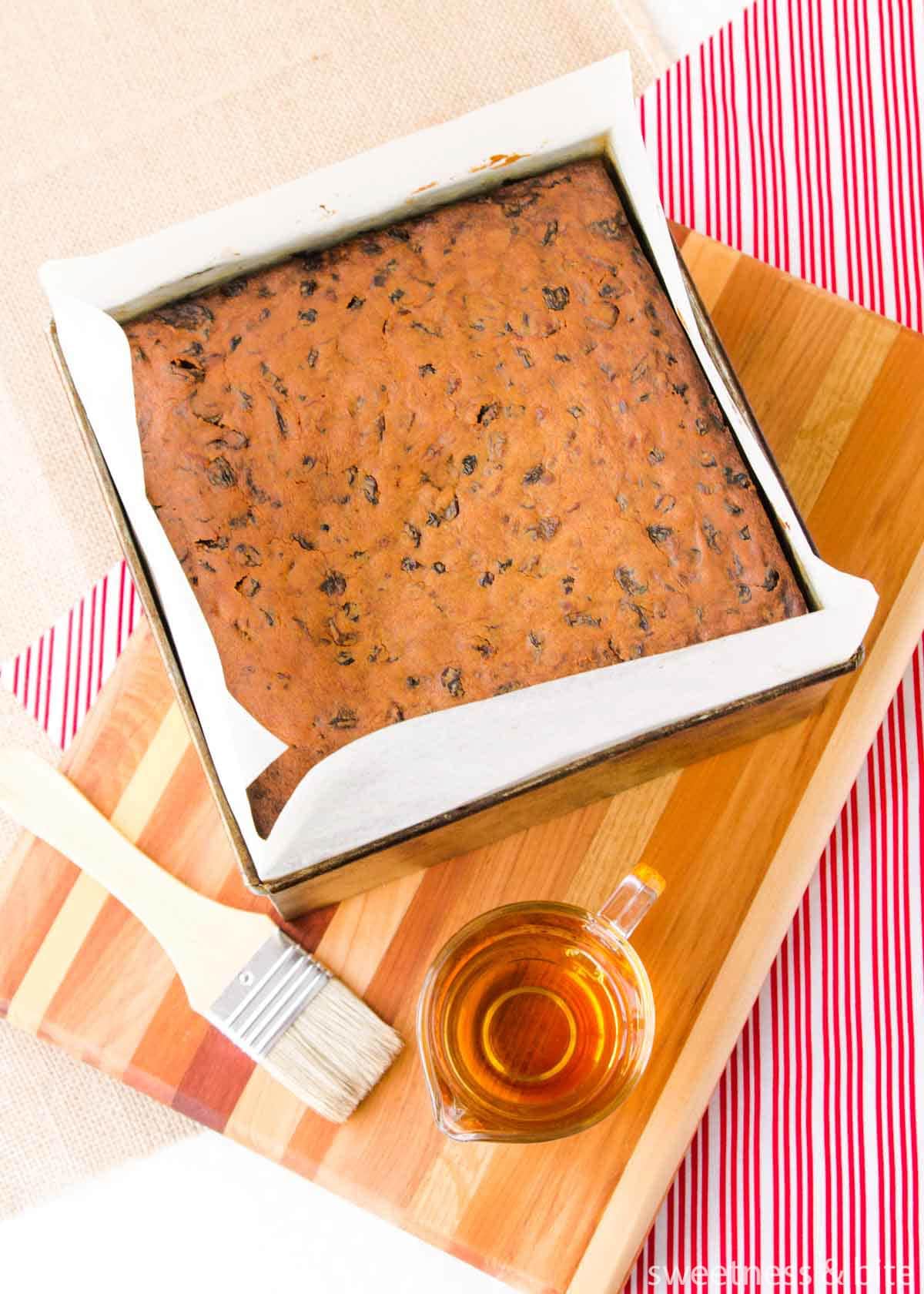
Fruit cake is traditionally made at least several months in advance of when it is supposed to be eaten. “Maturing” improves both the flavour of the cake and the ability to cut it into neat portions.
While the cake matures you can ‘feed’ it more alcohol, which keeps the cake moist. It also means you can store it for a long time without it going mouldy. For more info on maturing fruit cakes, check out this great post by Anges de Sucre.
I’ve often seen recipes for gluten free fruit cakes and Christmas cakes that say the cake should be made close to serving. I’m not sure why those particular ones say that, but this one here can be matured for just as long as an ordinary fruit cake. In fact, it benefits even more as it helps to stop the cake from crumbling, which can sometimes happen with gluten free cakes, depending on the flour you use.
Here’s how I store my gluten free fruit cakes:
- Brush the cake with alcohol when it comes out of the oven, cover the tin and allow the cake to cool completely.
- The next day, brush the top of the cake with more brandy, flip it out of the tin onto a large piece of plastic wrap, brush the remaining sides with brandy and then wrap it up completely in the plastic wrap.
- Pop it into an airtight container and store it in a cool dark place.
- “Feed” the cake occasionally, by carefully unwrapping the plastic wrap, brushing more alcohol over the surfaces of the cake, and then re-wrapping.
Having said all that, if you find yourself in mid-December and you haven’t baked your gluten-free Christmas cake yet, don’t despair! This cake is still pretty darn good even when made as a last-minute cake. In fact, the one pictured in this post was only made a couple of weeks before Christmas, and we had no complaints!

Check out the underside of the cake, and the lack of fruity indents…
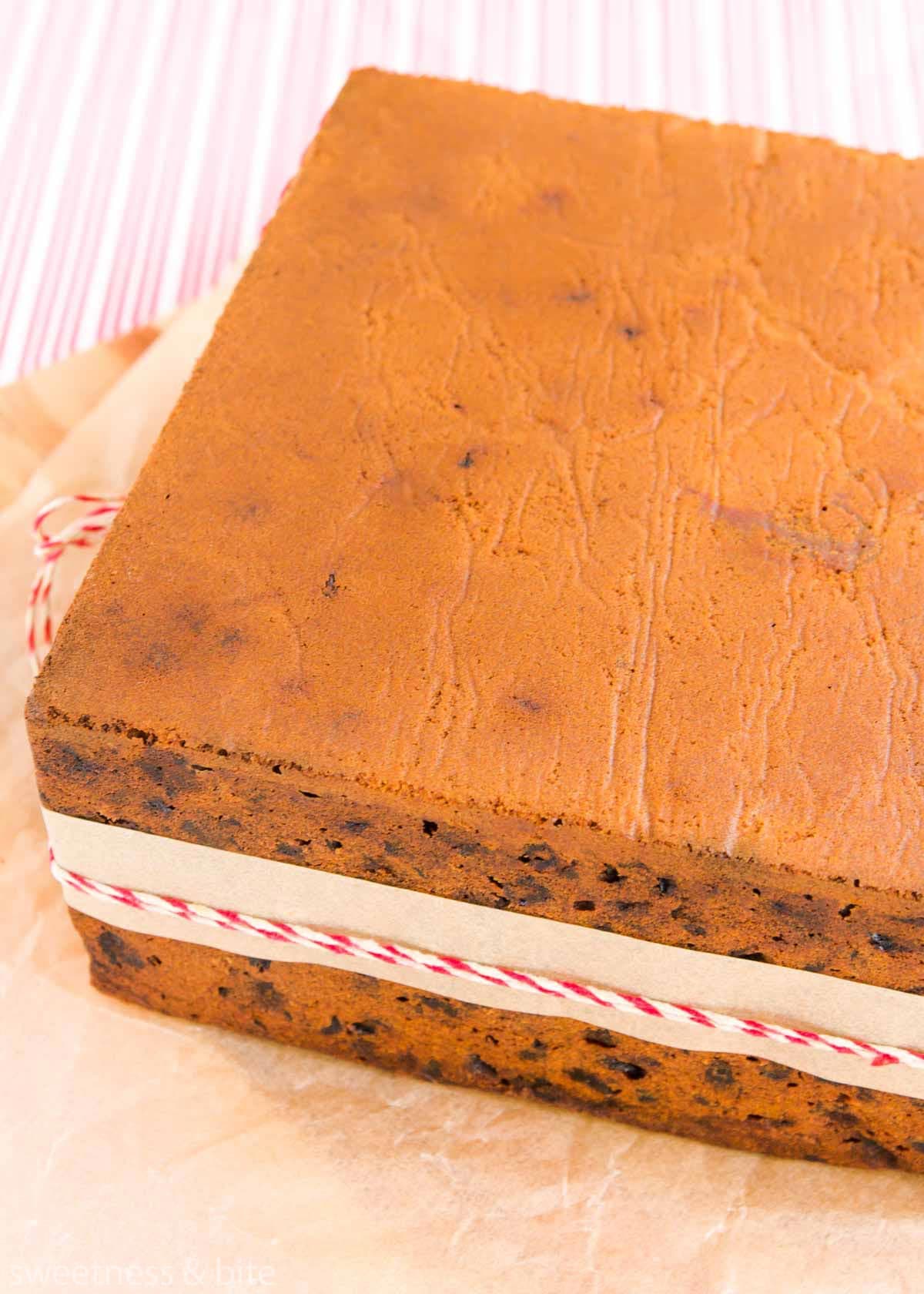
As I mentioned above, I only used the “batter trick” on the bottom, so you can see the difference here between the bottom and the sides, which still have holes. If you do it as I showed in the video above, the sides of the cake should be hole-free as well.
For more baking tips, make sure you check out my post on lining cake pans and making baking strips, and for gluten-free baking tips, check out this post too.
What to Do With Crumbly Fruit Cake
If worst comes to worst and for some reason, your fruit cake does turn out crumbly, here are two ideas for how to still enjoy it…
- Heat up the cake and serve it with some nice vanilla custard, brandy butter or ice cream. Ice cream is a nice summer option if you’re in New Zealand like I am, or any other country where it’s summer at Christmas time.
- Make some nice gluten free fruitcake truffles out of it. Just crumble some of the cake into a bowl, make some brandy buttercream or some brandy or almond flavoured white chocolate ganache, and mix just enough of that into the cake crumbs until the mixture will hold together nicely when you roll it into balls. Then dip them in some melted white or dark chocolate, or roll them in chopped nuts or sprinkles. A little bag of these would make a lovely festive gift!
If you’re a Christmas cake fan, you might also want to check out my gluten free mince pies. They’re super easy to make and filled with delicious homemade fruit mince (or you can use store-bought fruit mince to make them even quicker and easier!)
More Christmas Recipes:
Gluten Free Brandy Snaps
Gluten Free Trifle
Easy Peppermint Mousse
Gluten Free Fruit Cake Recipe
If you’re new to gf baking, or for more gluten free cake recipes, check out my Gluten Free Cakes for Decorating post.
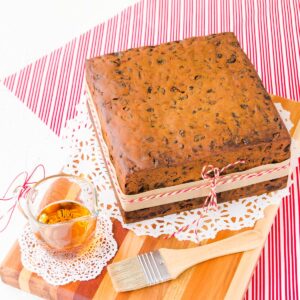
Gluten Free Fruit Cake (Christmas Cake)
Ingredients
- 1.5 kg mixed dried fruit* see notes
- 200 g glace cherries optional, replace with equal weight of another fruit if not using
- 50 g glace ginger finely chopped (optional)
- zest of 1 lemon or orange
- 150 ml brandy
- 500 g gluten-free flour**
- 1 ½ teaspoons xanthan gum
- 2 teaspoons ground cinnamon
- 1 teaspoon ground mixed spice
- 1 teaspoon ground ginger
- ¼ teaspoon ground cardamom optional
- ⅛ teaspoon freshly grated nutmeg optional
- 400 g butter at room temperature
- 400 g brown sugar or muscovado sugar
- 75 g golden syrup (¼ cup)
- 2 teaspoons vanilla extract
- 6 large eggs at room temperature
- Extra brandy for brushing
Instructions
- Cut any bigger dried fruit (like dates, apricots, prunes, etc.) into smaller pieces, about the same size as a raisin.
- Place the fruit and glacé cherries (if using) into a colander and rinse it under warm running water. You may need to do this in batches (I do each fruit separately as I weigh and cut it).Drain and place into a large bowl or plastic container.
- Add the glacé ginger, citrus zest and brandy. Stir well, cover and leave overnight (stir or shake it occasionally, if you remember).
- Preheat the oven to 150°C (approx. 300°F). Line an 8” square cake pan with baking paper, and wrap it with a baking strip. Make a foil lid. See this post for details on how to make those.
- Sift the flour, xanthan gum and spices into a large bowl, and whisk to combine.
- Place the butter, sugar, vanilla and golden syrup into the bowl of a stand mixer fitted with the paddle attachment (or use a hand mixer and a large bowl). Beat until fluffy, scraping down the bowl a couple of times.Lightly beat the eggs together in a small jug, then add gradually to the butter mixture, beating well in between additions. Don’t worry if it starts to look split.
- With the mixer on low speed, slowly begin adding the flour mixture a few spoonfuls at a time. Once all of the flour is added, scrape down the bowl and mix again.
- To make the bottom of the cake smoother (if you’ll be decorating the cake with the bottom as the top) then take out a few spoonfuls of batter and spread it over the bottom of the cake pan. Pop the pan into the fridge while you mix the fruit into the remaining batter.
- If your mixer bowl isn’t big enough to fit the fruit in as well, transfer the batter to a larger bowl or saucepan. Add the fruit (and any remaining brandy that hasn’t been absorbed by the fruit) and mix well until evenly distributed into the batter.
- Place a few large spoonfuls into the cake pan, and use a spatula or spoon to press it into the pan, especially the corners. Repeat until the pan is full. Wet your hands or a spatula and smooth the top.
- Bake the cake for 4 – 4.5 hours, or until a skewer inserted into the middle of the cake comes out mostly clean. To double-check, once the skewer comes out clean insert a thin-bladed knife into the cake and check that it comes out clean or with only a few crumbs attached.
- Leave to cool for 30 minutes, then brush or spoon over some more brandy. Fold down the baking paper, then cover the whole cake pan with foil and leave overnight to cool.
- To store and mature the fruit cake, turn the cake out onto baking paper, brush all sides with more brandy, then wrap well in the baking paper, and store in an airtight container. To further flatten the top of the cake, store it upside down. The weight of the cake will help it to flatten. You can continue to brush more alcohol onto the cake at regular intervals until the cake is served.
Notes
Nutrition
Nutritional Disclaimer: Any nutritional info provided is a computer generated estimate and is intended as a guide only.
Happy baking, and if you’re making this as your gluten free Christmas cake, then Happy Christmas! 💜
You May Also Like…

